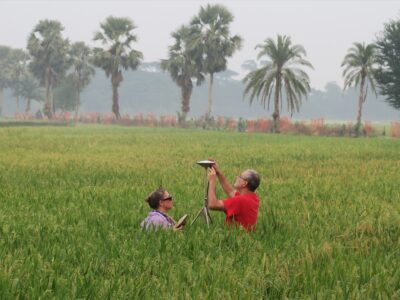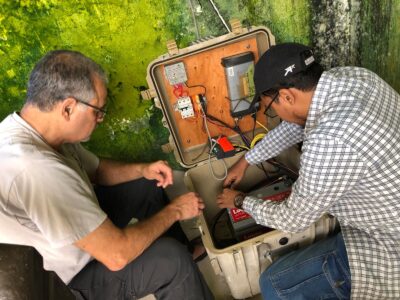
We planned to drill four or five tube wells across the abandoned channel and pick one for OSL dating samples. With the success of yesterday’s tube well drilling, we were optimistic that we could actually do the sampling. We met the drillers in the morning and headed to the next site. Since only two or three people are needed for logging the well, we left Céline and Basu and the rest of us headed off to do a short resistivity line near the first drill site. We scouted it during the drilling of the first well. On the way to the resistivity

site, we selected locations for three more wells. Depending on time, we will either drill two and then the sampling well or just three stratigraphic wells. Since it will be only 2 meter spacing between the electrodes, it will be quicker to set up despite less people. We are only trying to image the channel, so we don’t need a larger spacing. The site was also drier than the first two resistivity lines. We laid it out and started collecting data. My only concern was that the route was used as a path for local farmers collecting hay. I didn’t want them to knock off the electrode connections or to have them

shocked by the pulses of electricity we sent through the electrodes.
Once the line was running, I headed back to the drill site. They once again found a think mud layer over sand. They continued drilling deeper and found the silt clay that marks the boundary between the Holocene and Pleistocene, when sea level rose following the end of the last ice age. This was a bonus and confirmed that we were on line with the Lalmai anticline farther south. We shifted to the next line, a more difficult location next to a pond, but they managed. I headed back to the resistivity line and found them starting to pack up the equipment. When I went to take a look at the instrument, I found it hadn’t finished. It had run out of memory for recording line and stopped. We quickly reinstalled the electrodes that had been

pulled that we still needed. I deleted some older files that had already been downloaded and restarted acquisition. We had only lost four of 584 command lines.
By the time the second well and the resistivity line were done, it was questionable as to whether we could do the sampling well, which will take longer. The drillers going off for a lunch break settled it. We would do a third tube well today. During the drilling, the skies that had been threatening all day opened up.

The drillers and loggers got completely soaked, but kept going and we completed our five-well transect of the river valley. In the evening we compiled all the logs and discussed a sampling plan. Rather than take four samples in one well, we decided to take two, one above and one below the sand-mud transition in two different wells.
The OSL sample is over 2” wide and the wells we drilled were 1.5” wide. The driller decided it was best to drill a 1.5” well to the depth of the first sample, a few feet above the transition, and then overcore it to 3.5”. Then 3” wide PVC pipe

was lowered to keep the well from collapsing. Finally, we put the sampler on the auger rods and lowered it to the bottom of the well. We, actually people younger and stronger than me, pounded the sampler 30 cm into the bottom. Then we all had to pull up on it to get it out. The next step was to extrude the sample in its liner into a thick PVC pipe casing. The sample must be kept in the dark, so this was done inside a black plastic bag. Then the entire sample is wrapped in the black plastic bag and taped securely. The ends and outside of the sample will be discarded and only the core of the sample will be used for dating. Later, sample preparation will all have to be done in a darkroom. I helped sample on my last trip, but the was the first time I was in charge of the procedure. It went well. After the first sample, the drillers drilled to 1 ft. past the contact, overcored to the same depth, added the PVC liner and we sampled again. We

repeated everything for the second well and we had four OSL samples. We celebrated with green coconuts.



